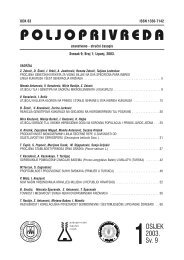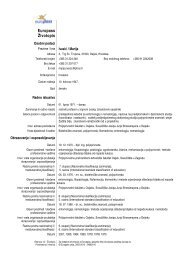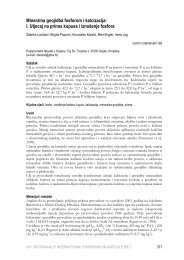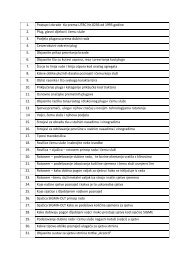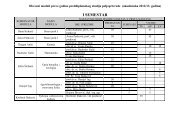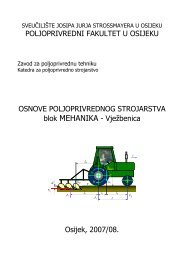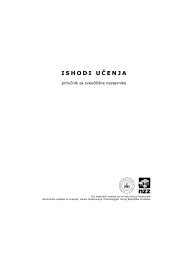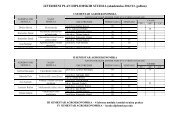Poljoprivreda 2-2006 final.qxd
Poljoprivreda 2-2006 final.qxd
Poljoprivreda 2-2006 final.qxd
You also want an ePaper? Increase the reach of your titles
YUMPU automatically turns print PDFs into web optimized ePapers that Google loves.
ISSN 1330-7142<br />
UDK = 381.13:639.1.02(497.5)<br />
GAME MEAT MARKET IN EASTERN CROATIA<br />
Z. Tolušić (1) , T. Florijančić (1) , I. Kralik (1) , M. Sesar (2) , M. Tolušić (3) Scientific review<br />
Pregledni znanstveni članak<br />
SUMMARY<br />
In the Republic of Croatia, game meat is consumed far less than meat of domestic<br />
animals. Yearly game meat consumption amounts to only 0.55 kg per household<br />
member. Consumers prefer meat of domestic animals, because it is cheaper, not<br />
paying attention to specific nutritive advantages of game meat. A research on the<br />
game meat market and consumers’ preferences was carried out on 101 examinees,<br />
chosen among inhabitants of Slavonia and Baranja. The majority of questioned<br />
inhabitants did consume game meat (92%), of whom 66% consider game meat to be<br />
of better quality than meat of domestic animals. Significant number of examinees<br />
considers game meat as healthy food, being also convinced that game was healthier<br />
to consume if hunted in their natural environment, than if reared on specialized<br />
farms (90%). Irrespective of quality, only 22% of examinees buy game meat,<br />
and 51% think such meat is too expensive. This is the main reason why consumers<br />
have game meat only once a month (51%). Taking into consideration monthly income<br />
of their respective household, 58% of examinees can afford game meat only<br />
once a month, and, if having an opportunity, they would opt for meat of roe deer<br />
(55%) and rabbit (25%). When asked what would stimulate the game meat market<br />
in Croatia, 56% of examinees believe this could be achieved by lowering of prices,<br />
27% think the issue could be addressed by opening of specialty stores, and only<br />
17% opted for more aggressive marketing activities.<br />
Key-words: market, game meat, consumers, consumption<br />
INTRODUCTION<br />
Game meat originates from hunted small or large<br />
game animals and is intended for consumption. It can<br />
also be obtained by slaughtering of intensively reared<br />
game animals (Živković, 2001). For many ancient tribes<br />
such meat represents, even today, a primary source of<br />
protein, and its consumption depends on unsustainable<br />
hunting of large game animals (Apaza et al., 2002). In<br />
developed countries, however, game animals are raised<br />
extensively, but also intensively on hunting enclosures,<br />
or farms. Recently, farmers show more interest in production<br />
of game meat, as there is awareness raised<br />
among consumers of health risks imposed by consumption<br />
of conventional red meat, which is high in saturated<br />
fat (Fletcher, 1997). On the other hand, because of its<br />
chemical composition, game meat has certain nutritive<br />
advantage over domesticated meats, and is perceived<br />
by consumers as a culinary specialty (Souci et al.,<br />
1979). Nutritive advantages of such meat refer to higher<br />
content of protein and less fats, which are though of<br />
more favorable fatty acid composition (Kulier, 1996).<br />
Bandik and Ring (1996) stated that game meat,<br />
especially meat of wild ruminant animals, rabbits and<br />
hares, was not only intensely flavored, but also low in<br />
fat and with favorable content of essential amino acids,<br />
unsaturated fatty acids and vitamins, thus being accepted<br />
as an important foodstuff.<br />
Comparing meat of domestic and wild animals,<br />
Paleari et al. (2003) claimed that meat of wild boar was<br />
similar to horse meat, as it was low in saturated fatty<br />
acids. Moreover, meats of wild boars, goats and cattle<br />
were similar with respect to their quantitative composition<br />
of monounsaturated fatty acids (MUFA), while<br />
horse meat was significantly higher in polyunsaturated<br />
fatty acids (PUFA), which were contained in deer meat<br />
only averagely and reduced in beef meat <strong>final</strong> products<br />
to the lowest (level. The content of free amino acids is<br />
1) Ph.D. Zdravko Tolušić, Associate Professor, Ph.D. Tihomir Florijančić,<br />
Assistant Professor and Igor Kralik, B.Econ – Josip Juraj Strossmayer<br />
University of Osijek, Faculty of Agriculture, Trg Svetog Trojstva 3, 31000<br />
Osijek, (2) Mate Sesar, B.Econ, Ph.D student of Faculty of Agriculture in<br />
Osijek, (3) Marija Tolušić, B.Econ, Economic and Adminiitrative School,<br />
Osijek<br />
POLJOPRIVREDA 12:<strong>2006</strong> (2) 58-63



